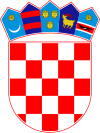
Neuschwanstein Castle is a 19th-century historicist palace on a rugged hill of the foothills of the Alps in the very south of Germany. It is located in the Swabia region of Bavaria, in the municipality of Schwangau, above the incorporated village of Hohenschwangau, which is also the location of Hohenschwangau Castle. The closest larger town is Füssen. The castle stands above the narrow gorge of the Pöllat stream, east of the Alpsee and Schwansee lakes, close to the mouth of the Lech into Forggensee.

Komárno, colloquially also called Révkomárom, Öregkomárom, Észak-Komárom in Hungarian, is a town in Slovakia at the confluence of the Danube and the Váh rivers. Historically it was formed by the "old town" on the left bank of Danube, present day Komárno in Slovakia, and by a "new town" on the right bank, present day Komárom in Hungary, which were historically one administrative unit. Following World War I and the Treaty of Trianon, the border of the newly created Czechoslovakia cut the historical, unified town in half, creating two new independent towns in two countries. Komárno and Komárom are connected by the Elisabeth Bridge, which used to be an official border crossing between Slovakia and Hungary until border checks were lifted due to the Schengen Area rules. In 2020, a new road bridge was opened.
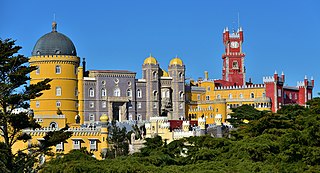
The Pena Palace is a Romanticist castle in São Pedro de Penaferrim, in the municipality of Sintra, on the Portuguese Riviera. The castle stands on the top of a hill in the Sintra Mountains above the town of Sintra, and on a clear day it can be easily seen from Lisbon and much of its metropolitan area. It is a national monument and constitutes one of the major expressions of 19th-century Romanticism in the world. The palace is a UNESCO World Heritage Site and one of the Seven Wonders of Portugal. It is also used for state occasions by the President of the Portuguese Republic and other government officials.

Thal is a village in the Austrian state of Styria, about 3.2 kilometres (2.0 mi) west from the edge of Graz, Austria's second largest city. Its population in the 2014 census was 2,240.

Nuremberg Castle is a group of medieval fortified buildings on a sandstone ridge dominating the historical center of Nuremberg in Bavaria, Germany.

Hvar is a town and port on the island of the same name, part of Split-Dalmatia County, Croatia. The municipality has a population of 4,251 (2011) while the town itself is inhabited by 3,771 people, making it the largest settlement on the island of Hvar. It is situated on a bay in the south coast of the island, opposite from the other nearby towns of Stari Grad and Jelsa.

The Harzburg, also called Große Harzburg, is a former imperial castle, situated on the northwestern edge of the Harz mountain range overlooking the spa resort of Bad Harzburg in Goslar District in the state of Lower Saxony, Germany. It was erected from 1065 to 1068 at the behest of King Henry IV of Germany, slighted during the Saxon Rebellion in 1073-75, and a century later rebuilt under Emperor Frederick Barbarossa and his Welf successor Otto IV, who died here in 1218.
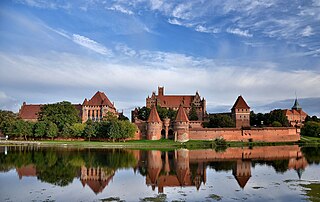
The Castle of the Teutonic Order in Malbork, commonly known as Malbork Castle, is a brick gothic castle complex located in the town of Malbork, Poland, built in 13th and significantly expanded in 14th century. It is the largest castle in the world measured by land area and a UNESCO World Heritage Site.

Veveří is an originally ducal and royal castle in Brno in the Czech Republic. It is located about 12 kilometres (7 mi) northwest of Brno city centre on the Svratka River.

Castel Nuovo, often called Maschio Angioino, is a medieval castle located in front of Piazza Municipio and the city hall in central Naples, Campania, Italy. Its scenic location and imposing size makes the castle, first erected in 1279, one of the main architectural landmarks of the city. It was a royal seat for kings of Naples, Aragon and Spain until 1815.
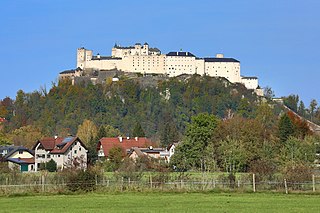
Hohensalzburg Fortress is a large medieval fortress in the city of Salzburg, Austria. It sits atop the Festungsberg mountain at an altitude of 506 m. It was erected at the behest of the prince-archbishops of Salzburg. The fortress is 250 m (820 ft) long and 150 m (490 ft) wide making it one of the largest medieval castles in Europe.

Ljubljana Castle is a castle complex standing on Castle Hill above downtown Ljubljana, the capital of Slovenia. It is a key landmark of the town. Originally a medieval fortress, it was probably constructed in the 11th century and rebuilt in the 12th century. It acquired its present outline with an almost complete overhaul in the 15th century, whereas the majority of the buildings date to the 16th and 17th centuries. Initially a defense structure and since the first half of the 14th century the seat of the lords of Carniola, it was since the early 19th century used for various other purposes and today is used as a major cultural venue.

The Palais de la Cité, located on the Île de la Cité in the Seine River in the centre of Paris, is a major historic building that was the residence of the Kings of France from the sixth century until the 14th century, and has been the center of the French justice system ever since, thus often referred to as the Palais de Justice. From the 14th century until the French Revolution, it was the headquarters of the Parlement of Paris. During the Revolution it served as a courthouse and prison, where Marie Antoinette and other prisoners were held and tried by the Revolutionary Tribunal. Since the early 19th century, it has been the seat of the Tribunal de grande instance de Paris, the Court of Appeal of Paris, and the Court of Cassation. The first of these moved to another Parisian location in 2018, while the other two jurisdictions remain located in the Palais de la Cité as of 2022.

Sokolac Castle is a castle in Brinje, Croatia. It is named after the Croatian word for falcon (sokol), which appears on the town's coat of arms.

The Palace of the Kings of Navarre of Olite or Royal Palace of Olite is a castle-palace in the town of Olite, in Navarre, Spain. It was one of the seats of the Court of the Kingdom of Navarre, since the reign of Charles III "the Noble" until its conquest by Castile (1512).
Surely there is no king with a more beautiful castle or palace and with so many gilded rooms (...) it could not say or even could imagine how magnificent and sumptuous is this palace (...)
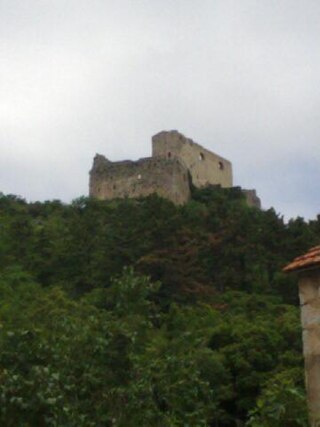
Prozor Fortress is a medieval fortress situated in the continental part of Split-Dalmatia County, in inland Dalmatia, just above the town of Vrlika in Croatia. From its origin as a small stronghold built by the ancient Illyrian tribe Dalmatae, it developed into a fortress in the 15th century, during the reign of Bosnian feudal lord Hrvoje Vukčić Hrvatinić.

The Royal Alcázar of Madrid was a fortress located at the site of today's Royal Palace of Madrid, Madrid, Spain. The structure was originally built in the second half of the ninth century by the Muslims, then extended and enlarged over the centuries, particularly after 1560. It was at this time that the fortress was converted into a royal palace, and Madrid became the capital of the Spanish Empire. Despite being a palace, the great building kept its original Arabic title of Alcázar.

The Willibaldsburg is a spur castle, built around the year 1353, in Eichstätt in Upper Bavaria. Until the middle of the 18th century, it was the representative castle and seat of Eichstätt's prince-bishops.

Kerestinec Castle is a castle constructed by the Erdödy family in Kerestinec, Croatia, near the town of Sveta Nedelja. It is a 1st category monument. It is a two-story structure with a square layout and cylindrical corner towers and open arcades in the courtyard. This is a Renaissance castle with fortified elements.

The Hanau City Palace is a former castle and palace in Hanau, Hesse, in Germany. It was the residence palace of the Counts of Hanau and later a secondary residence of the Electors of Hesse. The City Palace was also known as the Old Town Palace or later as the Electoral Palace.



























